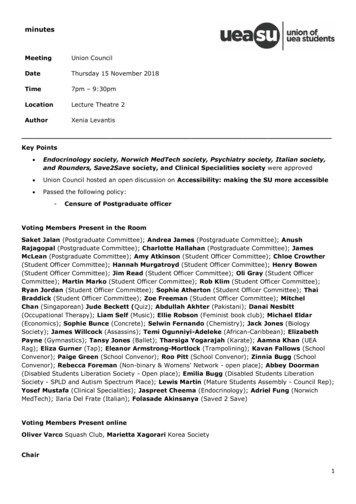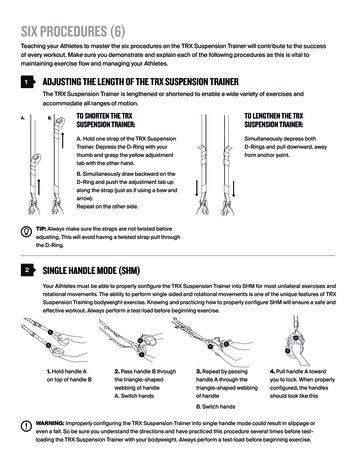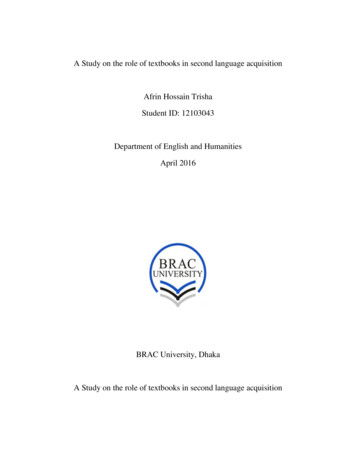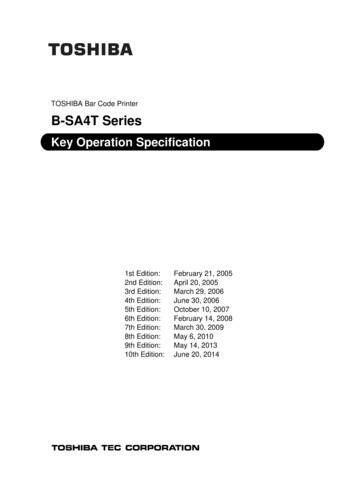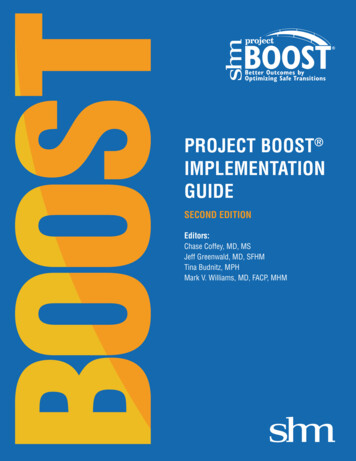
Transcription
Project Boost implementationguideSecond EditionEditors:Chase Coffey, MD, MSJeff Greenwald, MD, SFHMTina Budnitz, MPHMark V. Williams, MD, FACP, MHM
Copyright 2013 by Society of Hospital Medicine.All rights reserved.No part of this publication may be reproduced, storedin retrieval system,or transmitted, in any form or byany means, electronic, mechanical, photocopying,recording, or otherwise, without prior writtenpermission.Unlawful scanning, uploading and distribution of thisbook via the Internet or via any other means withoutthe permission of Society of Hospital Medicine may bepunishable by law.For more information or to obtain additionalcopies contact SHM at:Phone: 800-843-3360Email: BOOST@hospitalmedicine.orgWebsite: www.hospitalmedicine.org/BOOST
Implementation Guideto Improve Care TransitionsSECOND EDITIONFor more information about Project BOOST Visit www.hospitalmedicine.org/BOOSTThe Project BOOST logo is a federally registered trademark of the Society of Hospital Medicine.
i
The Project BOOST Team(Second Edition)Mark V. Williams, MD, FACP, MHMPrincipal Investigator, Project BOOSTProfessor of MedicineDirector, Center for Health Services ResearchUniversity of KentuckyLexington, KYTina Budnitz, MPHBOOST Project ArchitectSociety of Hospital MedicineAtlanta, GAChase Coffey, MD, MSSenior Staff HospitalistAssociate Medical Director forQuality and Performance ExcellenceHenry Ford Health SystemDetroit, MIJeffrey L. Greenwald, MD, SFHMCo-InvestigatorInpatient Clinician Educator ServiceMassachusetts General HospitalBoston, MAEric Howell, MD, SFHMCo-InvestigatorDirector of the Hospitalist DivisionDirector, Hospital CareJohns Hopkins Bayview Medical CenterBaltimore, MDGreg Maynard, MD, FHMCo-InvestigatorChief Medical Officer, Society of Hospital MedicineClinical Professor of MedicineChief, Division of Hospital MedicineUCSD Medical CenterSan Diego, CALauren O’SullivanProject BOOST National ManagerSociety of Hospital MedicinePhiladelphia, PAKimberly SchonbergerMarketing Project ManagerSociety of Hospital MedicinePhiladelphia, PAAdditional Contributors:Jing Li, MD, MSResearch Program DirectorProject Director, BOOST — IllinoisDivision of Hospital MedicineNorthwestern University Feinberg School of MedicineJessica Phillips, MSResearch CoordinatorDivision of Hospital MedicineNorthwestern University Feinberg School of Medicine
BOOST Mentors (Past and Present)Mark V. Williams, MD, FACP, MHMProfessor of MedicineDirector, Center for Health Services ResearchUniversity of KentuckyPrincipal Investigator, Project BOOSTPast-President, Society of Hospital MedicineFounding Editor, Journal of Hospital MedicineJeffrey Greenwald, MD, SFHMAssociate Professor, Harvard Medical SchoolInpatient Clinician Educator Service, MassachusettsGeneral HospitalCo-Investigator, Project BOOSTChase Coffey, MD, MSSenior Staff HospitalistDivision of Hospital MedicineHenry Ford Health SystemQuality AssociateHenry Ford West Bloomfield HospitalNasim Afsar-manesh, MDAssistant Clinical ProfessorInternal Medicine & Neurosurgery Associate Medical DirectorQuality & Safety UCLA Medical Center DirectorHospital Medicine & Neurosurgical Clinical QualityPrograms Ronald Reagan UCLA Medical CenterAziz Ansari, DO, FHMAssociate Director, Division of Hospital MedicineMedical Director, Loyola Home Care and HospiceAssistant Professor of MedicineLoyola University Stritch School of MedicineNeal Axon, MDAssistant ProfessorMedical University of South CarolinaRichard B. Balaban, MDAssistant Professor of Medicine, Harvard Medical SchoolAssociate Chief of Hospital MedicineCambridge Health AllianceRebecca Daniels, MD, FACPAssociate Program Director, Internal Medicine Director,Clinical Research, Internal MedicineSt. Joseph Mercy Health SystemDaniel D. Dressler, MD, MSc, FHMDirector of Education, Section of Hospital MedicineAssociate Program Director, J Willis Hurst InternalMedicine ResidencyDirector, Internal Medicine Teaching Services,Emory University HospitalVikram K. Devisetty, MD, MBA, MPHAssistant Professor of Medicine, Division of Hospital MedicineNorthwestern University Feinberg School of MedicineLuke Hansen, MD, MHSLead Analyst, Project BOOSTAssistant Professor of MedicineNorthwestern University Feinberg School of MedicineKeiki Hinami, MD, MSAssistant Professor of Medicine, Division of Hospital MedicineNorthwestern University Feinberg School of MedicineLakshmi Halasyamani, MD, FHMVice President for Quality and Systems ImprovementSaint Joseph Mercy Health SystemCo-Investigator, Project BOOSTEric Howell, MD, SFHMAssociate Professor of MedicineDirector, Johns Hopkins Bayview Hospitalist DivisionJohns Hopkins University, School of MedicinePresident, Society of Hospital MedicineCo-Investigator, Project BOOST
BOOST Mentors (Past and Present)(Continued)James Haering, MDSparrow HospitalChristopher Kim, MD, MBA, SFHM,Associate Professor of Internal Medicine and PediatricsMichigan Hospitalist ProgramAssociate Medical Director, Faculty Group PracticeAssistant Chief of Staff, Office of Clinical AffairsGreg Maynard, MD, MSc, SFHMCMO, SHMDirector, UCSD Center for Innovation and Improvement ScienceUniversity of California, San DiegoCo-Investigator, Project BOOSTJoseph R. Munsayac, MDAssistant Professor of Medicine, Division of Hospital MedicineNorthwestern University Feinberg School of MedicineJanet Nagamine, RN, MD, FHMHospitalistKaiser Permanente; Santa Clara, CACo-Investigator, Project BOOSTAndy Odden, MDClinical Instructor, Internal MedicineUniversity of MichiganAmitkumar R. Patel, MD, MBAAssistant Professor of MedicineDivision of Hospital MedicineNorthwestern University Feinberg School of MedicineChithra Perumalswami, MDAssistant Professor of Medicine, Division of Hospital MedicineNorthwestern University Feinberg School of MedicineJennifer Quartarolo MD, FHMAssociate Clinical Professor of MedicineUniversity of California San DiegoStephanie Rennke, MDAssociate Clinical Professor of MedicineUniversity of California San Francisco Medical CenterJeff Rohde, MDClinical Associate Professor, Internal MedicineUniversity of MichiganLakshmi Swaminathan, MDAssistant Director, Internal MedicineOakwood Hospital and Medical CenterMohammad Salameh, MDDirector of Hospital MedicineSt. Joseph Mercy HospitalGregory Smith, MD, FHMAssistant Professor of Medicine, Division of Hospital MedicineNorthwestern University Feinberg School of MedicineElizabeth Schulwolf, MD, MADivision Director, Hospital MedicineAssistant Professor, Loyola University Stritch School ofMedicineDavid Vandenberg, MD, SFHMMedical Director, Outcomes ManagementSt Joseph Mercy Hospital-Ann ArborArpana R. Vidyarthi, MDCo-Investigator, Project BOOSTAssistant Professor of Medicine, Director of Qualityand Safety Division of Hospital Medicine and GraduateMedical Education InstitutionUniversity of California San FranciscoWinthrop F. Whitcomb, MD MHMMedical Director, Healthcare QualityBaystate Medical CenterSpringfield, MACo-Founder and Past President, Society of Hospital MedicineKendall Williams, MD, MPHDepartment of Medicine Service ChiefPenn Presbyterian Med CenterRobert Young, MD, MSAssistant Professor of Medicine, Division of Hospital MedicineNorthwestern University Feinberg School of Medicine
Executive SummaryThe Society of Hospital Medicine (SHM) enthusiastically introduces the Second Edition of the Project BOOST Implementation Guide.Since its launch in 2008, Project BOOST (Better Outcomes by Optimizing Safe Transitions) has helped more than 180 hospitals and healthsystems improve their care transition processes.SHM is the first national medical association to be recognized by the National Quality Forum and The Joint Commission with the John M. EisenbergPatient Safety and Quality Award for Innovation in Patient Safety. The award acknowledges SHM for its innovative mentored implementationmodel, which has been utilized in more than 300 hospitals, touching the lives of tens of thousands of patients across the country. ProjectBOOST — SHM’s signature mentored program — serves as a national model for improving the quality of care and reducing hospitalreadmissions. Project BOOST has also been recognized by the Centers for Medicare & Medicaid Innovation (CMMI) as an evidencebased approach to reducing readmissions. In addition to achieving reductions in unnecessary readmissions, some sites report increasedpatient satisfaction and improved length of stay in the hospital. Currently, more than 180 hospitals participate in Project BOOST, over1,000 health care professionals participate on its active Listserv and more than 5,000 people have downloaded the original Project BOOSTImplementation Guide and Toolkit.This Second Edition incorporates the many lessons learned through BOOST mentor interactions with sites throughout the United Statesand Canada. For any site considering adoption of Project BOOST, please note the following: Project BOOST should be considered a platform on which other interventions can be layered. Adoption of this program influencesmore than just the discharge process, and consequently it provides benefits beyond reducing unnecessary readmissions. ProjectBOOST sites develop improved interprofessional work environments and communication, proactively identify and mitigate patients’risk factors for poor transitions from the hospital, and enhance patient and caregiver satisfaction through more effective interactions. Project BOOST is not a “one size fits all” program; each organization must understand its current state of care transitions and tailor theBOOST tools and concepts to meet its needs, priorities, resources and culture. The sustainable success of Project BOOST at institutions requires the engagement of many stakeholders. Executive leadership iscritical, as is engagement with front-line staff (e.g., nurses, case managers, social workers, pharmacists and physicians), both in thehospital and post-acute care setting. Implementing Project BOOST takes time, with the desired culture change and the full impact occurring within 12 to 24 months. Project BOOST mentors are key to overcoming barriers to implementation, helping teams stay focused, as well as highlightingsuccesses. These individuals can offer important guidance on how best to navigate the political landscapes that major projects suchas these may encounter. The Project BOOST online community is a tremendous resource where organizations can share stories,lessons learned, tools and insights.iPROJECT BOOST IMPLEMENTATION GUIDE
What’s New in the Second Edition?With the new edition, SHM has incorporated the latest data from the medical literature on improving care transitions, and hasredesigned the Implementation Guide to reflect lessons we have learned from working with BOOST sites. The ImplementationGuide includes five sections: Section I: Improving Care Transitions Section II: Laying the Foundation for Improvement Section III: Getting to Work on Improving Transitions of Care Section IV: The BOOST Toolkit Section V: Best Practices in Care Transitions — Annotated BibliographyThis new design will help sites move through the work of improving care transitions using “lean” problem-solving employed bymany highly successful organizations such as Toyota. In addition, the BOOST tools have been updated, refined and are easierto use.How to Use the Implementation GuideSHM designed the Implementation Guide to function as a workbook. As you move through the material, you will be asked to completespecific tasks that will help you improve your care transition processes. Your team will start by understanding “why” — why it is importantto improve care transitions at your organization, and why does your current situation exist? Next, your team will develop a shared mentalmodel on your objectives for this important work. Finally, your team will strategically implement the BOOST tools to help you achieve yourobjectives.While this recipe for success may sound simple, it is hard work — and your team will face obstacles along the way. To help youovercome these obstacles we have also redesigned the Project BOOST website so that it is more user-friendly and aligned with the newImplementation Guide in order to provide additional support and resources to BOOST teams.Institutions officially enrolled in the Project BOOST Mentored Implementation Program can take advantage of additional online resources,as well as a growing online BOOST community. This group regularly discusses how to improve the care transition process and sharesresources with one another on how to expedite implementation and expand on the BOOST interventions.In addition, BOOST-mentored sites receive one-on-one mentorship from a physician expert in care transitions and change management.This mentor is an invaluable resource who can help your team engage your institution’s leadership and front-line staff to facilitatecollaboration and overcome obstacles or barriers that may impede your progress. This mentorship accelerates design and launch of theBOOST interventions at your hospital, assists in the training of your staff and helps you assess outcomes.To learn more about joining the BOOST online community or becoming a mentored implementation site, visitwww.hospitalmedicine.org/BOOST.Again, welcome to the Second Edition of the Project BOOST Implementation Guide. The Project BOOST Team thanks you for working toimprove patient care and wishes you much success at achieving Better Outcomes by Optimizing Safe Transitions.Chase Coffey, MD, MSJeff Greenwald, MD, SFHMTina Budnitz, MPHMark V. Williams, MD, FACP, MHMii
Table of ContentsSection I: Improving Care TransitionsChase Coffey, MD, MS; Jeffrey L. Greenwald, MD, SFHM; Mark V. Williams, MD, FACP, MHMA Patient’s StoryBetter Outcomes by Optimizing Safe Transitions23Section II: Laying the Foundation for ImprovementChase Coffey, MD, MS; Jeffrey L. Greenwald, MD, SFHM; Mark V. Williams, MD, FACP, MHMStep 1: Ensure support from the institutionStep 2: Assemble an effective teamStep 3: Clarify key stakeholders, reporting hierarchy and approval processStep 4: Survey previous or ongoing efforts and resourcesStep 5: Set SMART goals and a timelineStep 6: Decide on key metrics and a measurement planStep 7: Choose a hospital care unit on which to implement BOOST11131718192021Section III: Getting to Work on Improving Transitions of CareChase Coffey, MD, MS; Jeffrey L. Greenwald, MD, SFHM; Mark V. Williams, MD, FACP, MHMStep 1: Understand the background context at your institutionStep 2: Understand how your current care transition process functions and where it failsStep 3: Establish a quantitative data collection planStep 4: Understand why there are deficiencies in your current processStep 5: Select and tailor interventions to fix the root causes of any deficienciesStep 6: Implement solutions to improve your care transition processStep 7: Track your performanceStep 8: Sustain the success of your interventionsStep 9: Report back to your stakeholdersStep 10: Spread the improvementiiiPROJECT BOOST IMPLEMENTATION GUIDE27283236374247484950
Table of ContentsSection IV: The BOOST ToolkitJeffrey L. Greenwald, MD, SFHM; Mark V. Williams, MD, FACP, MHM;Chase Coffey, MD, MS; Jing Li, MD, MS; Robert Young, MD, MSIntroduction to BOOST ToolsAssessing Patient Risk for Adverse Events After Discharge — The 8PsAssessing the Patient’s Preparedness for Transitioning Out of the HospitalPatient-Centered Written Discharge InstructionsTeach BackFollow-up Telephone CallsFollow-up AppointmentsInterprofessional RoundsPost-Acute Care TransitionsMedication Reconciliation52535657586062646669Section V: Best Practices in Care Transitions Annotated BibliographyJing Li, MD, MS; Jessica Phillips, MS; Mark V. Williams, MD, FACP, MHMAppendicesAppendix A: Teach Back ProcessAppendix B: Talking Points to Garner Institutional SupportAppendix C: Sample Letter to AdministrationAppendix D: Project BOOST Return on Investment (ROI)Appendix E: Record Your WorkAppendix F: Tools for Running an Effective MeetingAppendix G: Tools for Care Transition Improvement Team RosterAppendix H: Tools for Identifying Key Stakeholders, Committees and GroupsAppendix I: Tool for Performing Institutional AssessmentAppendix J: Tools for Establishing General AimsAppendix K: 8P ToolAppendix L: General Assessment of Preparedness (GAP Tool)Appendix M: Patient PASS: A Transition Record and Discharge Patient Education Tool (DPET)Appendix N: The Project BOOST Advisory Board (original iv
PROJECT BOOST IMPLEMENTATION GUIDE
First StepsSection IImproving Care Transitions1
A Patient’s StoryMs. Jones, a 72-year-old woman, was admitted to a local hospital for community-acquiredpneumonia. She received treatment with intravenous antibiotics and quickly improved. On hersecond hospital day, however, she developed an episode of atrial fibrillation, and the cardiologistwho evaluated her started two new medications for treatment, including an anticoagulant. Onher fourth hospital day, the hospitalist deemed her stable for discharge. The physician wrotethe discharge order, quickly completed a discharge summary and within an hour, Ms. Jonesexited the hospital and took a taxi home. Upon her discharge, she was given prescriptions fororal antibiotics, the anticoagulant and the medication to control her atrial fibrillation. These newmedications were added to her existing medications for diabetes, hypertension, hyperlipidemiaand arthritis. She was also instructed to follow up with her primary care physician and thecardiologist “in one to two weeks after discharge.” Widowed and living alone, Ms. Jones did notdrive and depended on a neighbor for transportation. Because her neighbor was working, Ms.Jones could not get a ride to her local pharmacy and, consequently, failed to fill her prescriptions.Within a few days of leaving the hospital, Ms. Jones had a worsening cough, her heart wasracing and her pulse was irregular. She reviewed her discharge instructions for advice on whatto do, but she found the paperwork unhelpful as it was full of medical jargon. She called herprimary care physician who scheduled an appointment with her for the following week. The nextday, her neighbor became concerned because she did not see Ms. Jones walking her dog asusual. The friendly neighbor went over to her house and, getting no response to knocking on thedoor, entered to find Ms. Jones lying on the sofa, unable to talk and not moving her right side.The neighbor called 911.2PROJECT BOOST IMPLEMENTATION GUIDE
First StepsBetter Outcomes by Optimizing Safe TransitionsWhy Improve Care Transitions?Improving care transitions is important for three main reasons:1) Failed care transitions result in patient harm.2) Healthcare reform aligned financial incentives to stimulate system improvements in care transitions.3) Optimized care transition processes improve outcomes, including patient satisfaction and reducedreadmission rates.First, and most important, failed care transitions result in patient harm. Research in the past 10 years documents that upto 49% of patients experience at least one medical error after discharge,1 and one in five patients discharged from thehospital suffers an adverse event.2,3 It is important to note that up to half or more of these adverse events are preventable orameliorable, primarily through improved communication among providers. Information transfer and communication deficitsat the time of hospital discharge are common, with direct communication between physicians occurring less than 20% ofthe time, and discharge summaries often lack important information and/or are unavailable when patients present for posthospitalization follow-up with their primary physicians.4 Additionally, many patients are discharged with test results pending,and left with loose ends such as additional testing after discharge.5,6 Furthermore, many patients lack understanding of theirhospitalization diagnosis and treatment plans,7 resulting in patients not being able to care for themselves after discharge.Eventually, these mistakes result in about one in five Medicare patients being rehospitalized within 30 days of hospitaldischarge.8Second, healthcare reform implemented by the Patient Protection and Affordable Care Act of 2010 has better alignedthe financial incentives to stimulate healthcare systems to work on improving care transitions. The new law does so byboth penalizing hospitals with excessive rates of rehospitalization, and supporting programs to help healthcare systemsimprove care transitions. As in the case of Ms. Jones in the story at the beginning of this section, a common result of a“failed” hospital discharge is subsequent rehospitalization resulting from harmful events after discharge. Such unnecessaryrehospitalizations cost billions of dollars annually. Reacting to these unnecessary costs, the Medicare Payment AdvisoryCommission (MedPAC) recommended to Congress in June 2007 that hospitals should publicly disclose their own riskadjusted readmission rates.9 This suggestion became official policy with the passage of the Affordable Care Act on March23, 2010. Since the beginning of 2013, those hospitals with higher-than-expected readmission rates for the diagnoses ofpneumonia, heart failure and acute myocardial infarction have begun receiving a reduction in Medicare reimbursement ofup to 1% for all Medicare diagnosis-related group (DRG) payments.10 This maximum financial penalty is 2% in FY2014,and 3% in FY2015, resulting in potential loss of reimbursement for some hospitals in the millions of dollars. Beyond thepenalties, though, hospitals and physicians can now receive reimbursement for care coordination for discharged patients.Physicians can use Current Procedural Terminology (CPT) codes 99495 and 99496 when they arrange for an early postdischarge follow-up appointment or make contact with a patient shortly after discharge. Combined with an increasingemphasis on patient-centered care, hospitals’ desire for high-quality patient care and patient satisfaction is now aligningwith reimbursement for quality instead of quantity.3
Third, beyond the financial penalties, the Patient Protection and Affordable Care Act created programs to help hospitals andproviders improve care transitions. The Centers for Medicare & Medicaid Services (CMS) started one of these programs,the “Partnership for Patients,” creating a “nationwide public-private partnership that offers support to physicians, nurses,and other clinicians working in and out of hospitals to make patient care safer and to support effective transitions of patientsfrom hospitals to other settings.”11 In fact, CMS recommends Project BOOST as one of the care transition models for thecommunity-based care transitions program. Following the principles and standards set forth by the Transitions of CareConsensus Policy Statement, medical home providers can ensure a safe transition for patients and help them navigate ourcomplex health system.12The Picture of a Broken Care TransitionRegardless of whether a patient is being discharged from the hospital to home or to an extended care facility (e.g., nursinghome, rehabilitation center, assisted living, long-term acute care hospital), the discharge process has numerous potentialpitfalls that can create harm for patients. As the figure below illustrates, well-intentioned, hard-working clinical staff dotheir best to provide a safe care transition, but these efforts are hindered by various broken or failed processes within thehealthcare system. When combined, the broken processes may result in adverse events going unchecked and causing harmto the patient.Traditional Care TransitionsPoor communicationPatient issuesNonstandardized careSystem failuresPatientsHard workAdverseeventsGood intentionsSmart caregiversInvestedModified from Reason J. Human error:modelspatientsand management. BMJ. 2000;320:768-770.4PROJECT BOOST IMPLEMENTATION GUIDE
First StepsIt is important to recognize that the transition process does not start with the physician writing an order for the patient tobe discharged. Instead, preparing patients and their families/caregivers for a safe transition starts at admission (or beforeadmission, if the admission is elective). By starting the discharge care transition early in a patient’s hospital stay, we haveopportunities to identify more potential failure points (e.g., potential issues that may lead to adverse events) in the processsuch as: Failure to identify patients with an increased risk for adverse events after discharge including readmission Failure to conduct an accurate and/or complete medication reconciliation process Failure to assess or anticipate what the patient and family/caregiver may need at the time of discharge Failure to develop an interdisciplinary care plan that incorporates the input of other members of the care team, such asthe nurse, pharmacist or case manager/social worker or even the patient and family/caregiver.During a patient’s hospital stay, healthcare providers might compound their mistakes madeat the start of the hospitalization by: Failing to initiate care processes to ameliorate readmission risk factors Failing to educate patients and their families/caregivers in a patient-centered manner, resulting in patients andfamilies/caregivers who do not know how to stay healthy after discharge Failing to address key concerns of the patient and family/caregiver.At the time of discharge, healthcare providers might further undermine the transition of care plan by: Providing patients with discharge instructions full of medical jargon and failing to use “Teach Back” (see Appendix A) toconfirm adequate understanding Inadequately communicating with primary care physicians or other aftercare providers about the patient’s hospitalcourseand ongoing diagnostic and treatment plans Providing a discharge summary to outpatient providers that is incomplete, delayed or missing a clear care plan for thepatient after discharge Failing to complete an accurate medication reconciliation process, often because the medication reconciliation onadmission is inaccurate Failing to work with patients and their families/caregivers to coordinate follow-up visits with outpatient healthcareproviders soon after discharge.There are also things healthcare providers might do, or fail to do after discharge, that undermine thecare transition process, including: Rarely checking on patients after they have left the hospital, resulting in missed opportunities to identify early warningsigns of an adverse event Failing to give patients the resources needed to handle events if their condition worsens at home Failing to send completed discharge summaries with essential information to primary care physicians or other aftercareproviders in a timely fashion Failing to connect patients to community resources that will help them achieve lasting health and wellness.5
A picture of our current state of the care transition process is shown below:Why Patients Get Readmitted:A DESIGN Root Cause AnalysisAdapted from Chris Kim, MDOn Admission:During Hospitalization:At Discharge: Poor communication withprior providers Redundant testing Inadequate medication information Limited efforts to identify risks andbarriers to successful transition Poor communication amongmembers of care team, includingoutpatient providers Delays in initiating interventions toimprove transitions Insufficient involvement of patientand family/caregiver in dischargeeducation/plan Failures to clarify goals of care Appointments made when patientand family/caregiver cannot attend Discharge instructions cumbersome Inadequate information handoffs Error-prone medicationreconciliation Rushed educationPost-Discharge: Little/Late/No contact with patientpost-discharge (hospital/PCP or othercaregiver) Patients and families/caregiversunaware of how to manage acuteproblems discharge is subsequent rehospitalization or morbidJones, a common result of a “failed” hospital LIFE HAPPENS (social, financial,barriers) of Care Consensus Policy Statement,the principles and standards set forth logistical,by the clinicalTransitionsAs in the case of Ms.outcomes. Followinghospitalists and primary care providers (future patient-centered medical homes) can ensure a safe transition for patients andhelp them navigate our complex health system.12 The ideal care transition process does not have the failure points describedabove, and instead, uses care delivery systems and staffing models to shore up each of these potential failure points. Asshown in the illustration on the following page, some of the key aspects of the ideal care transition process include: Screening patients for readmission risk factors Creating an interdisciplinary plan of care through interprofessional rounds Accurate medication reconciliation on admission and discharge Educating patients and families/caregivers using a patient-centered approach (e.g., Teach Back) that assesses theirunderstanding Providing patients with useful and succinct written information about their discharge instructions produced at anappropriate literacy level Engaging patients and/or families/caregivers in scheduling a timely follow-up appointment with their primary carephysician prior to discharge, and ensuring the patient has transportation to that appointment Speaking with patients after discharge to assess how they are doing at home, ensuring they have the services they needand addressing any issues or questions that may have developed after discharge In selected higher risk or more vulnerable patients, linking them to transitional care services including communityservices or nursing as exemplified by models from Coleman13 and Naylor14Your hospital is likely addressing some of these steps to ensure a safe care transition. If so, you are well on the way toimproving the care t
SHM designed the Implementation Guide to function as a workbook. As you move through the material, you will be asked to complete specific tasks that will help you improve your care transition processes. Your team will start by
